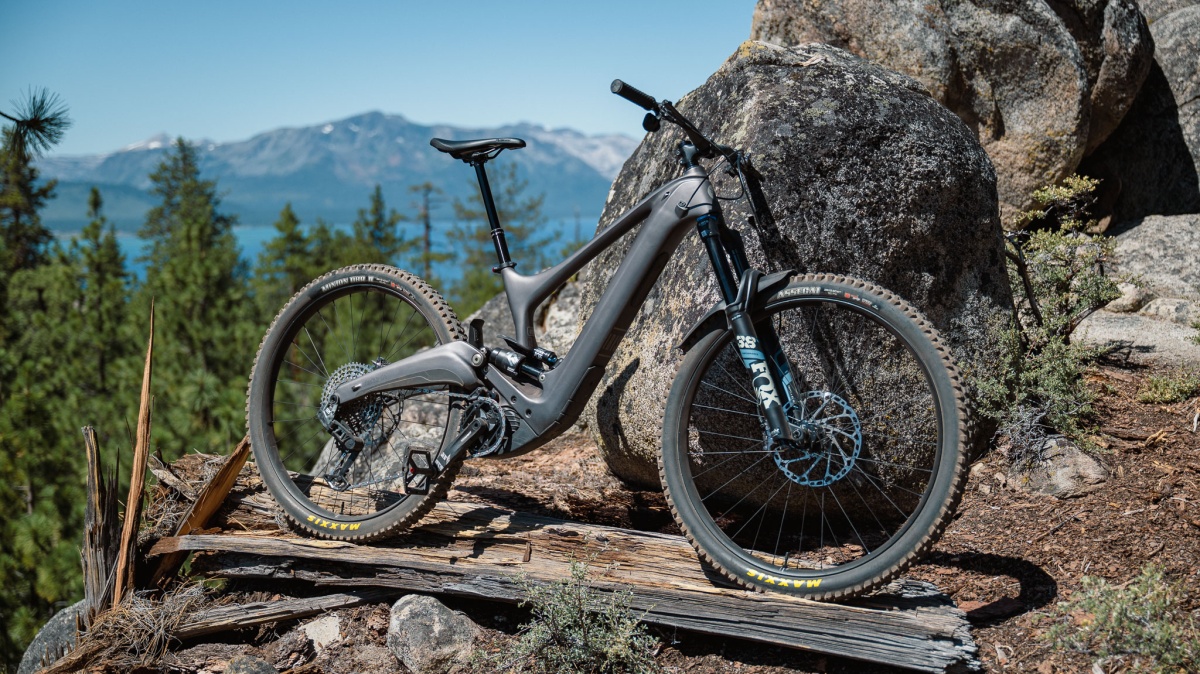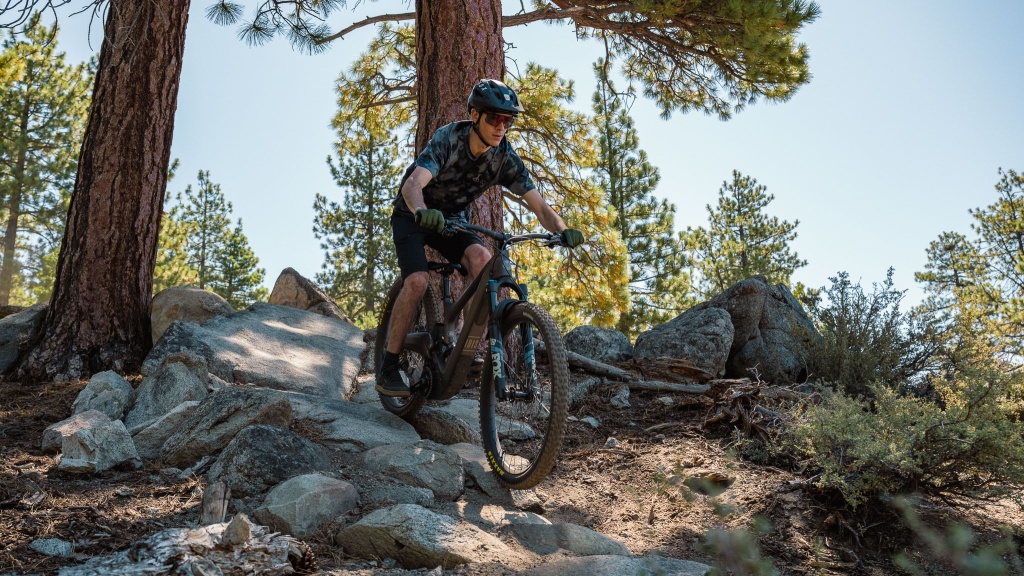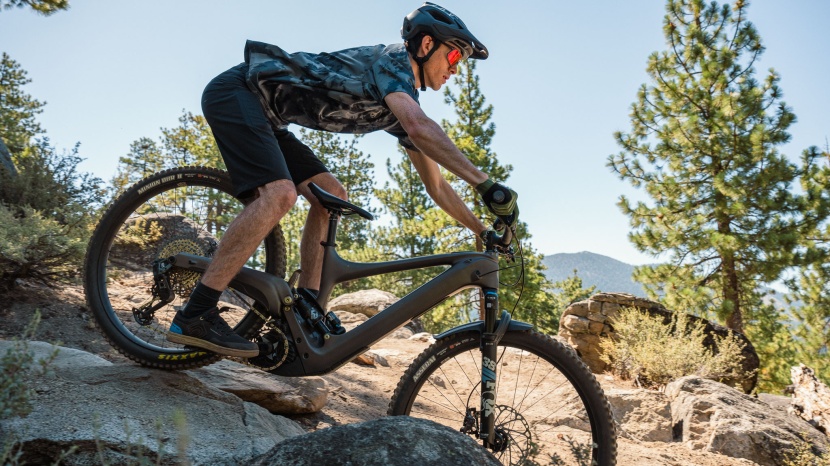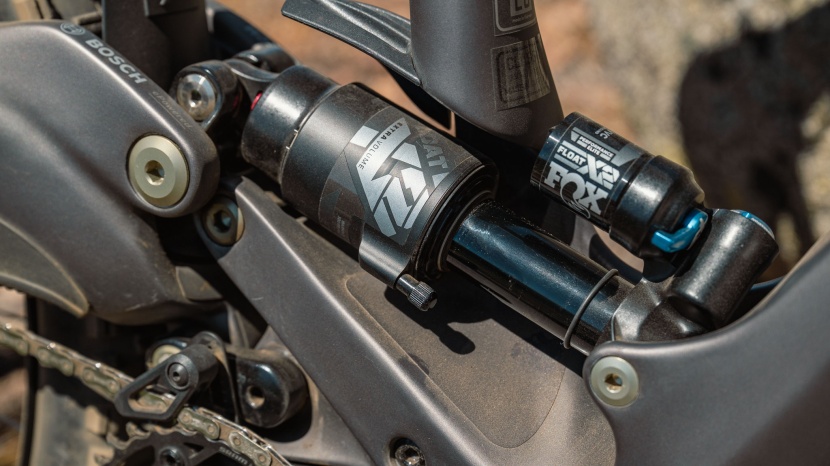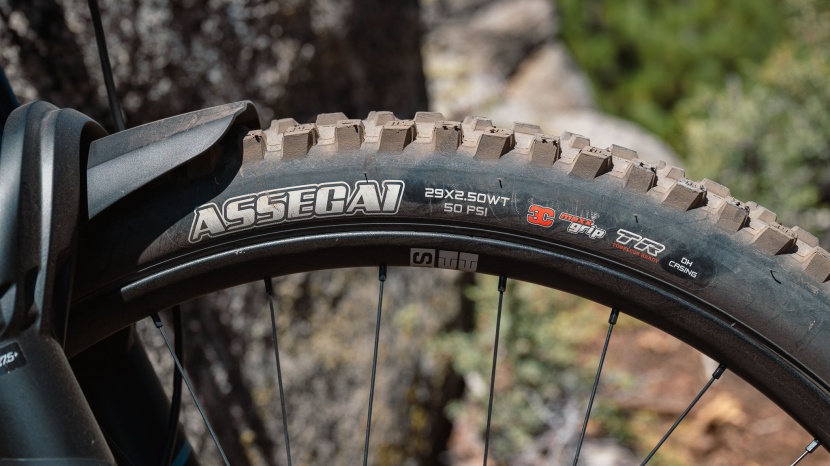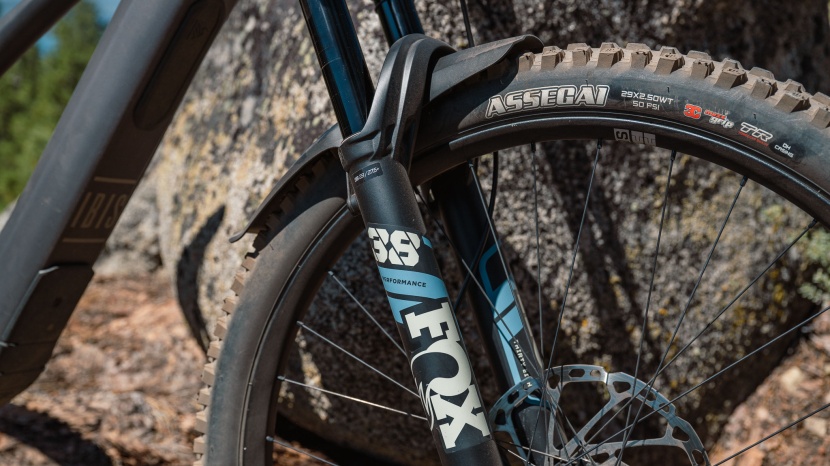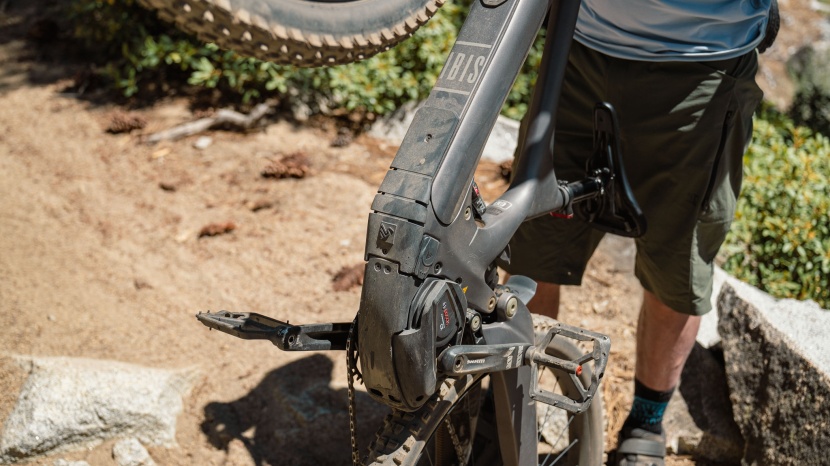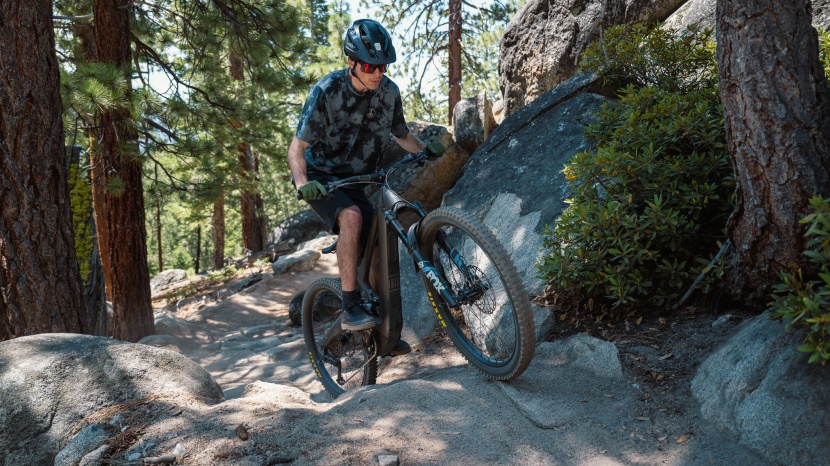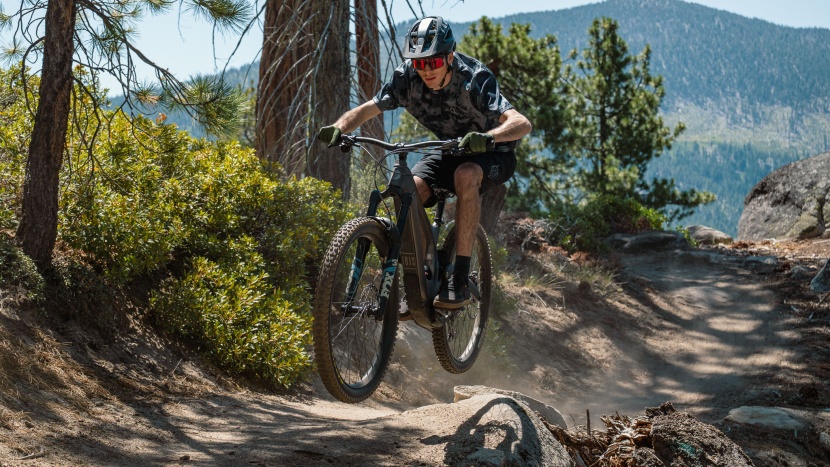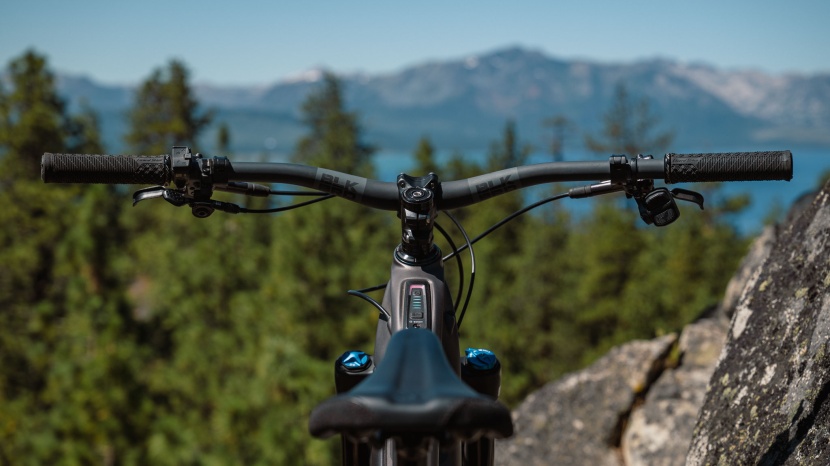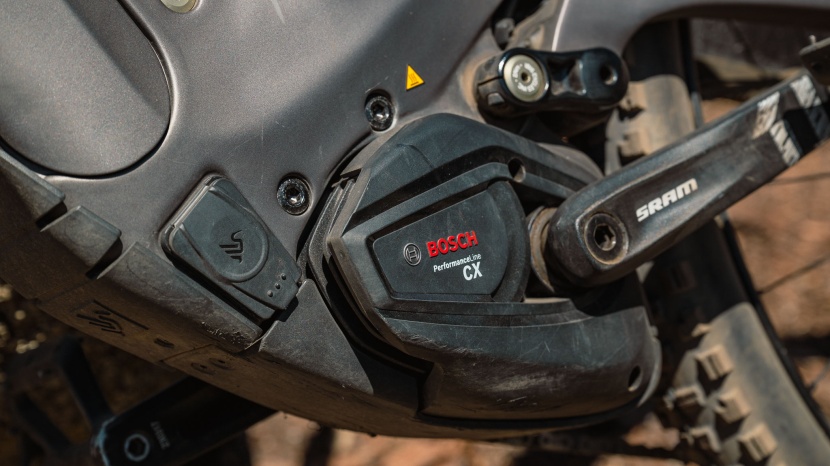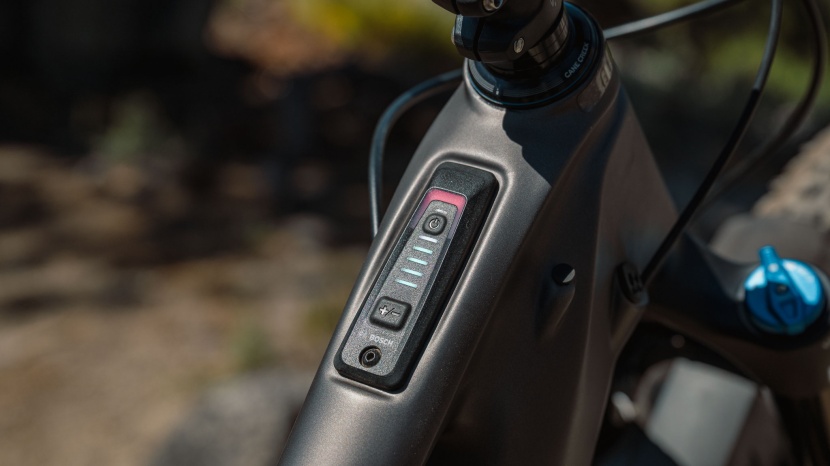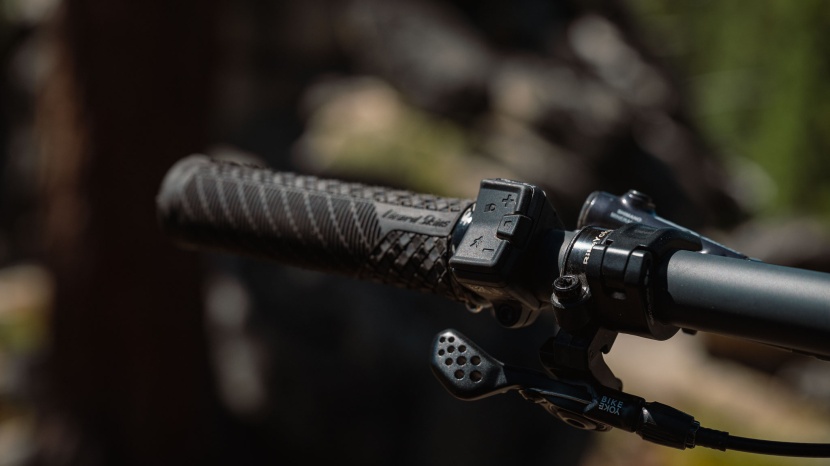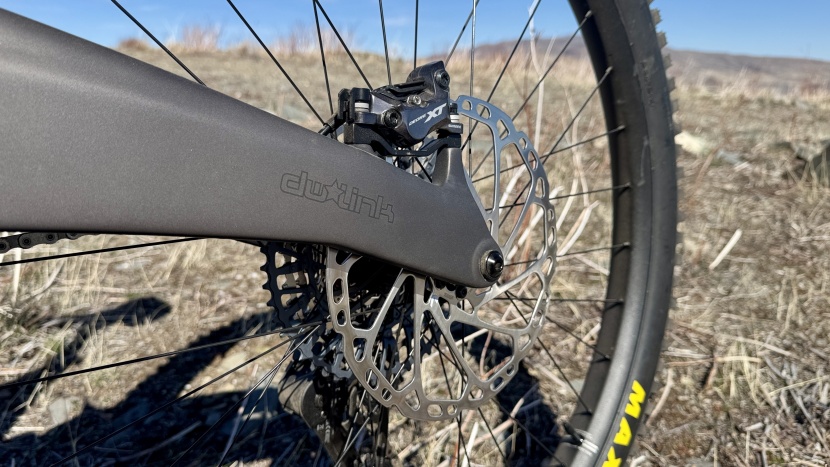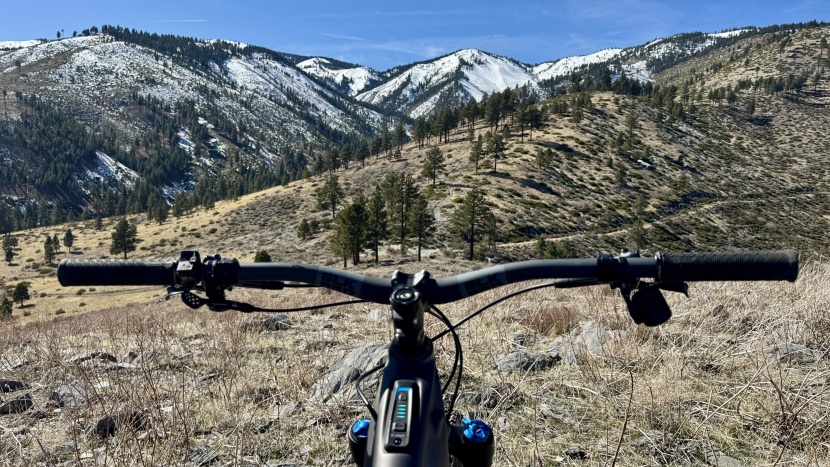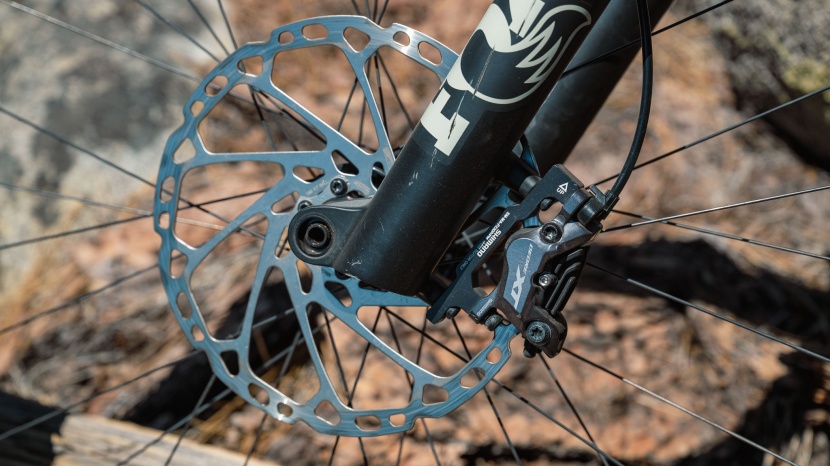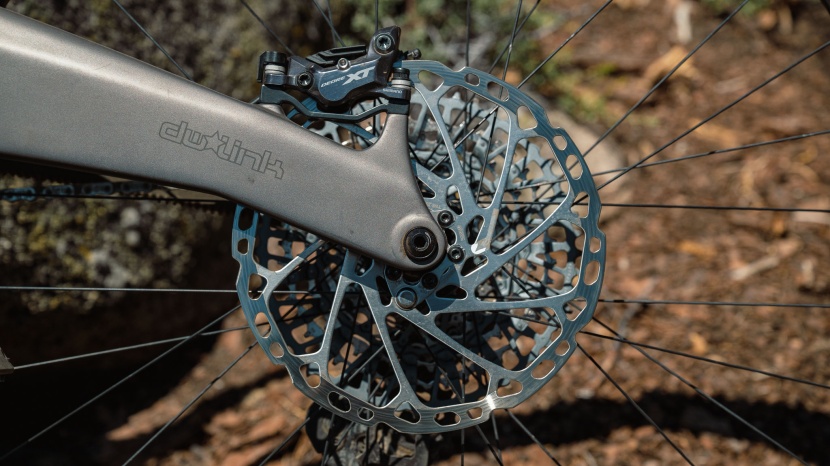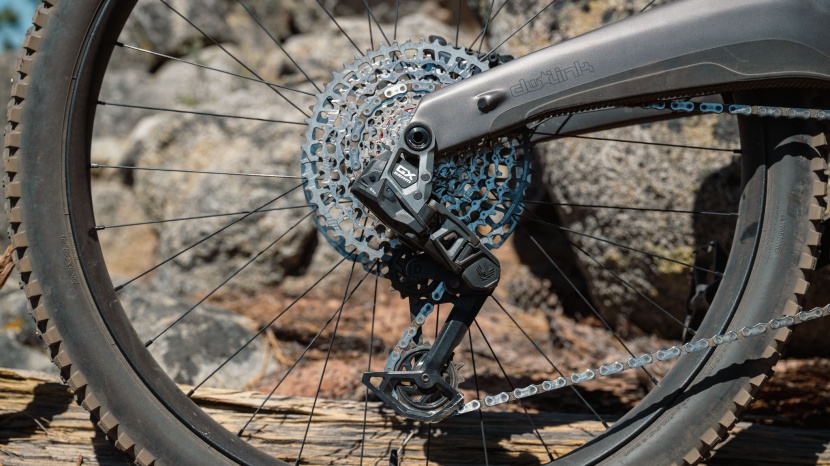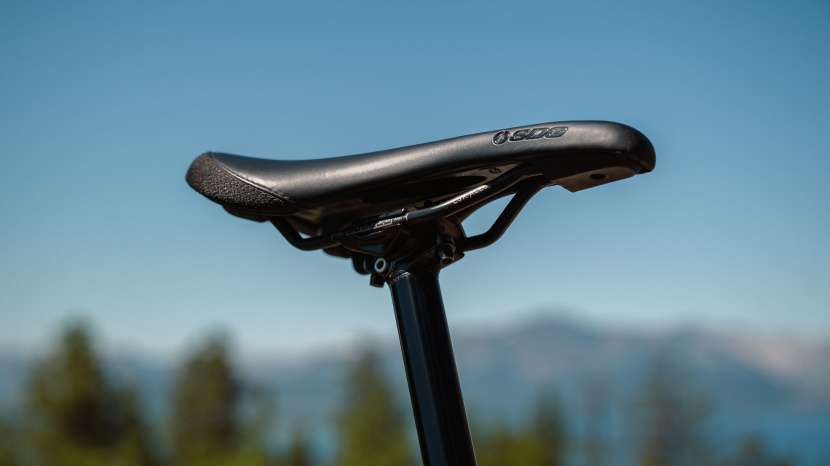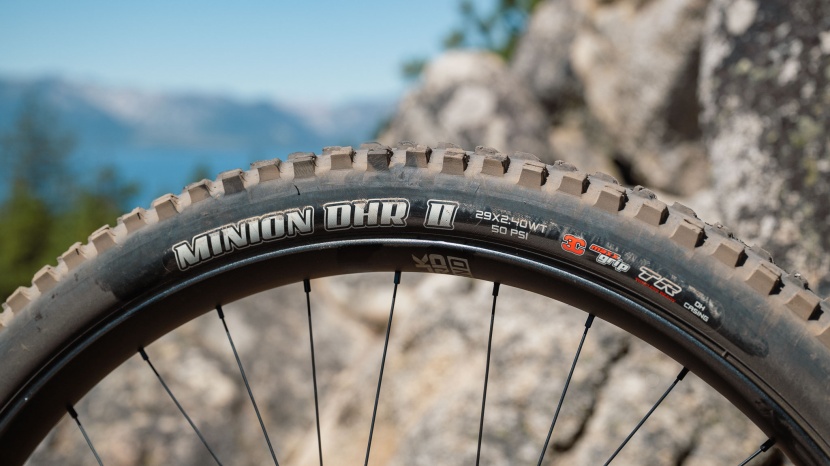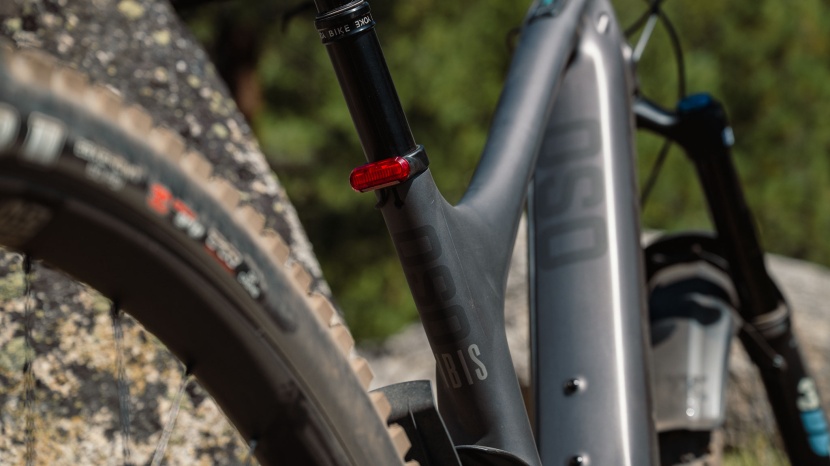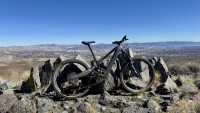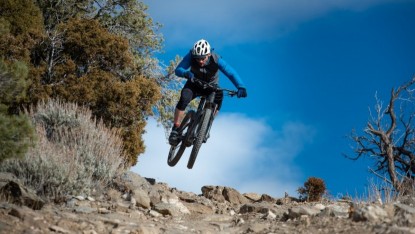
Our Verdict
Our Analysis and Test Results
Ibis launched the original Oso back in 2023 with a price tag of nearly $11,000. It was a crazy feat of engineering, with the company creating a first-ever, upper-link suspension dw-link platform to provide the space for its Bosch power plant. The bike was impressive, but its 5-figure price tag didn't help it stand out in a crowded market. When Ibis announced the Oso 1.1 with an improved Transmission drivetrain and updated Bosch display at under $6500, it blindsided the market and made us do a double-take. The all-carbon frame has 155mm of rear travel paired with a 170mm fork, which can be upgraded to 170mm in the rear and a 190mm single-crown fork. Is the new Oso too good to be true?
Downhill Performance
Studying the geometry and parts spec, you can see that Ibis wasn't holding back or cutting corners. Peering over the 64-degree headtube is 170 mm of Fox 38 and a Maxxis Assegai with DH casing, Ibis understood the mission. Our size large test bike has a limo-like 1294mm wheelbase, making it the longest of the powered mountain bikes to grace our test trails. That length and travel give the Oso the stability to challenge speed limits, but consequently, leave it feeling less agile.
The bike's length is well distributed with a 500mm reach, and 444mm of chainstay supporting the 29" rear wheel. The Small and Medium sizes use a 27.5" rear wheel and 439mm of rear center. The Oso doesn't back down from high-speed descents; it feels courageous and encourages you to push the limits of the trail.
When Ibis spec'd this bike, they favoured capability over everything else. The Fox 38 is infallible in rough terrain, and 170mm of travel lets you pick lines with abandon. The burly DH casing on the Maxxis tires offers relentless grip, and their profile on the Blackbird Send 35mm rims gives them an even more pronounced stance. XT 4-piston brakes and 220mm rotors make full use of the bike's traction and give you the type of traction that seems to test physics. The HiFi carbon handlebars feel like a bonus for comfort and control at this price point. While we're fond of the flex characteristics of a 31.8 bar / stem, the juncture looks undersized on the massive Oso.
The name Oso is Spanish for bear, and like a bear ripping open car doors in Yosemite, the Oso feels overqualified for much of the terrain we subjected it to. Super long descents felt surprisingly calm with no brake fade or change in the suspension as we accumulated heat. The bike's 53.5 lb weight made us less inclined to seek out the fun side hits and big airs, and more likely to plow down the middle of the challenging lines. We started testing this bike toward the tail end of our Ibis Ripmo V3 GX AXS testing, and while the bikes have some similarities on paper, they ride in very different ways. We'd wager that much of that difference comes from the extra 20 pounds that the Oso is carrying.
The Oso has trophy truck energy; it feels confident and capable, plowing through terrain that overwhelms other bikes. It also feels serious, it's down for business, and less willing to find those whimsical, playful lines that the Santa Cruz Vala R seemed to eat for breakfast. It's certainly a fun bike to ride, but its larger wheels and longer legs give it a less energetic and poppy feel.
Climbing Performance
The climbing prowess of an electric mountain bike is more than the power and torque coming from the motor, but those are certainly contributing factors. The Bosch Performance Line CX motor dishes out 600 watts of assistance and up to 85 Nm of torque. These aren't the biggest numbers in motorized power, but they give the Oso the grunt to conquer some pretty steep pitches. Ample reach (500mm on our Large) gives you a roomy cockpit, while a 78-degree seat tube angle puts you on top of the bottom bracket and allows you to generate plenty of your own power.
There are a couple of aspects of the build that really enhance its climbing performance; the X2 shock and DW-Link rear end give the wheel a stuck-to-the-ground feel. Couple this with the wider rim and contact patch, and you have outstanding traction in loose and lumpy terrain. The bike is also quite heavy, so in places where another bike with the same wheels and suspension might falter, the Oso claws through. You can sit back and have a passive climbing experience with the motor in its higher power settings; there's plenty of power to let the bike do the work and keep your heart rate low. Conversely, you can opt for just the amount of strain you want and toggle through the motors' lower settings.
The 64-degree head tube isn't ideal for ascending big pitches, but the longer chainstays and kinematics never let your center of mass fall behind the rear axle, so you don't experience the amount of front-end wandering you might expect with this aggressive geometry. Our testers were unanimous in the opinion that this bike is at least as much fun uphill as it is downhill. The experience of climbing with almost reckless abandon, knowing the bike could conquer any line you encountered, was exciting and rewarding. Fingers on the brake levers and adrenaline pumping through your system isn't generally associated with going uphill, but that's what we experienced.
When you encounter a sharp switchback or need to wheelie or manual a technical move, the bike feels less ideal. The longer chainstays and higher mass hinder your attempts to make quick vertical moves. The motor can help you lift the front end in a wheelie, but we found manuals exceptionally difficult on the Oso. The large rear wheel does wonders for smoothing your ride and overcoming chunky bits of trail, but it also makes the bike feel less spry.
The rear end does a decent job of parsing out the inputs, with overall good small bump sensitivity and a supportive range just beyond its sag. We experienced less anti-squat than we've experienced on other DW-link driven frames. There is a bit more of a dive in the rear end when you load the drivetrain up with power. This would be a bigger issue on an acoustic bike, but the motor's assistance largely negates any negative consequence of the squat you experience.
Power Output
The Bosch Performance CX Line motor is widely used and revered, and for good reason. It's durable, efficient, and has a fairly compact form factor for a full-powered unit. The motor houses not only cadence and torque sensors but also acceleration and tilt sensors that inform the system of the conditions you're riding. Our test bike uses the 4th generation motor and produces 85 Nm of torque and 600 watts at peak power. The 5th generation of this motor received a software update to increase those numbers to 100 Nm of torque and 750 watts; it's unclear if newer Oso's will use the updated motor.
The bike can have a maximum of four ride modes; the stock modes are: ECO, eMTB, TOUR+, and TURBO. They offer progressively more assistance and correspond to colors on the top tube display: green, blue, purple, and red, and as you'd expect, range diminishes as you ramp up the power.
Through the app, you can select different ride modes from eight different offerings, and each mode can be customized. The customization options allow you to program more or less assistance, adjust the dynamic, which dictates how fast the drive unit responds to your pedaling input, and the max speed and torque for each mode. My personal preferences for the Bosch motor involved lowering the assistance by one notch and increasing the dynamic, which made the motor feel more immediately responsive to my input but not too punchy. The app also allows you to lock, register, and report issues with the bike. In the event your bike is stolen, you can report it through the app, although it isn't clear what Bosch does with that information.
Range
The Oso packs a 750-watt Bosch PowerTube in its downtube, the largest (and heaviest) that Bosch offers with this motor line. To understand just how efficient the bike is, we set out for an afternoon of hill climbing. With the Oso tuned to TURBO mode, we pointed it uphill and ran intervals with minimal input. This gives us a worst-case scenario for range, but since we do the same test with each of the electric mountain bikes we test, it also provides a valuable comparison. Most of the e-mtb's we test do not have integrated lighting, so we didn't use the Oso's lights during this test.
At the end of our range test, we had ridden 30.9 miles while climbing over 6000'. While Bosch sells a POwerMOre Range extender, the water bottle eyelets on teh Oso aren't designed to hold its weight. We've seen people velcro the battery on or attach a battery bag but its an unorthodox approach. Since we rode with minimal input (approximately 100 watts), you can likely get significantly further by adding a bit more leg power or riding in a lower power mode.
E-bike Controls
The Bosch Smart System toptube display is pretty simple with two buttons and five small LED indicators. There are some clever ways they convey more information from such a basic-looking design. The top of the display uses a color-changing LED to display your ride mode, and the descending LEDs each represent 20% of the battery. When you've used 10% of the battery, the upper LED changes colors to allow for a more accurate indication of charge. When you reach the final 20% of battery life, the remaining lights turn red to alert you to some potentially hard pedaling in your future.
The Smart Controller connects to a wireless handlebar remote that allows you to change modes, turn the lights on, or engage walk mode without moving your hand from the handlebars. The wireless remote uses its own battery, which made me a tad nervous as having yet another battery to worry about felt like more potential problems but the ride modes can also be changed on the top tube display. Additionally, the remote uses very little power; after close to 200 miles and six charge cycles on our main battery, the remote was at 97% charge, a value you can check through the app.
Powering the Oso on or off is done on the top tube with a simple, quick push. Points to Bosch or this, as some of the e-bikes we test require pushing the button and holding it for several seconds, which gets old with continued use. Charging the bike is done with a 4 amp charger, allowing a full charge of the 20.1 ah battery in just over 5 hours. The charge port is located on the non-drive side, just in front of the motor on the down tube. Should you choose to charge the battery off the bike, there is a button and light display on the Power Tube that allows you to see its level of charge.
Build
Ibis offers exactly one build for the Oso. While highly unconventional, we can't argue with their outstanding specs, and there are few, if any, parts we'd change. If they built a higher-end version of the Oso, it likely wouldn't enhance the bike's performance. GX AXS shifts just as well as the XO, and lessening the engagement with the freehub wouldn't make the bike feel sportier. They could also come to market with a lower-cost model, but it would be hard to imagine how that wouldn't negatively affect performance.
Ibis didn't cut corners with the build, and some of their proprietary innovations have found their way onto the bike. Aluminum inserts at the ends of the carbon bars (Moron the ends) allow you to trim the length without cutting the carbon. Signature wide rims give the WT tires a wider profile that results in a larger and more stable contact patch, which doesn't roll sideways or wiggle in a bottom-out event. The Fox Performance 38 is a highlight. We test many bikes at higher price points that run Rythym 36's that lack the chassis stiffness or dampening adjustments to make the most of your ride. Ibis even included lights! A 900 lumen Lupine SL F Nano front light wires into the battery, and a seat collar integrated Lupine C14 taillight puts out 45 lumen.
We often critique a build and want to add better brakes or carbon handlebars, but there's really nothing that we want to change on the Oso. Of course, there will be some personal preferences when it comes to the cockpit, but we found the bike's build to be perfect. It's especially impressive when you consider the price, way to go, Ibis.
Should You Buy the Ibis Oso?
The Oso 1.1 has a spectacular build with an exceptional price tag, but that doesn't mean it's the right bike for you. If your idea of a great ride is crushing big mountain lines with confidence and composure, the Oso will do that all day long. If you want an agile feeling trail bike that rides more like an acoustic bike, you'd be wise to look elsewhere. In some ways, riding an e-bike is almost like a different sport, like Ibis says, it's downhill both ways. You're less likely to be carefully finessing lines and finding fun little opportunities to catch some air on the Oso, but it's not lacking in the fun department. If the sport were divided into two categories, the Oso epitomizes the e-mtb experience; it feels less like a trail bike but may open you up to options of going bigger and further than you ever imagined.
What Other Electric Mountain Bike Should You Consider?
The Santa Cruz Vala R uses the same Bosch motor, a smaller battery, and mixed wheels to create a more nimble, high-energy ride. While we found the Santa Cruz to be a poor value, especially compared to the Oso, it's incredibly fun to ride. The Specialized Levo using the 3.1 Brose motor is the bike we recommend for most aspiring e-bike riders. Its geometry is wildly adjustable and its output can be customized to a greater extent than most. The Levo uses a massive 840Wh battery and can use a 280Wh range extender, giving it tremendous range for epic journeys.
| Awards | Most Capable Electric Mountain Bike |
|---|---|
| Price | $6,449 List |
Overall Score  |
|
| Star Rating | |
| Bottom Line | Crushes the technical descents and climbs with effortless finesse, the Oso trades its sportiness for rugged capability |
| Pros | Brawny, Composed, Excellent value, Long-travel compatible |
| Cons | Heavy, Long wheelbase |
| Rating Categories | Ibis Oso 1.1 |
| Downhill Performance (30%) | |
| Climbing Performance (25%) | |
| Measured Effective Range (25%) | |
| Power Output (15%) | |
| E-Bike Controls (5%) | |
| Specifications | Ibis Oso 1.1 |
| Battery Size (Wh) | 750Wh |
| Wheel size (inches) | 29 |
| Motor System | Bosch Performance Line CX |
| Motor Power (torque) | 85Nm |
| Measured Weight (w/o pedals) | 53 lbs 8 oz (Large) |
| Measured Effective Range | 30.9 miles |
| Fork | Fox Float Performance 38 170mm |
| Suspension & Travel | DW-Link |
| Shock | Fox Performance X2 |
| Frame Material | Carbon Fiber |
| Frame Size Tested | Large |
| Available Sizes | S-XL |
| Wheelset | Blackbird Send Aluminum 35mm internal, Ibis hubs |
| Front Tire | Maxxis Assegai, 29 x 2.4”, 3C MaxxGrip, DD, TR |
| Rear Tire | Maxxis Minion DHR II, 29” x 2.4”, 3C MaxxGrip, DD, TR |
| Shifters | SRAM AXS Pod |
| Rear Derailleur | SRAM GX Eagle Transmission |
| Crankset | SRAM X1 E-mtb |
| Crankarm length | 165mm |
| Cassette | SRAM XS1275 10-52t |
| Chain | SRAM GX Eagle |
| Saddle | SDG Bel Air V3 |
| Seatpost | Bike Yoke Revive 185mm |
| Handlebar | Blackbird HiFi Carbon 800mm |
| Stem | Ibis 31.8 50mm |
| Brakes | Shimano M8120 4-piston |
| Grips | Lizard Skin Single Clamp |
| Measured Effective Top Tube (mm) | 638 |
| Measured Reach (mm) | 500 |
| Measured Head Tube Angle | 64 |
| Measured Seat Tube Angle (effective) | 78 |
| Measured Bottom Bracket Height (mm) | 340mm |
| Measured Wheelbase (mm) | 1294 |
| Measured Chain Stay Length (mm) | 444 |


